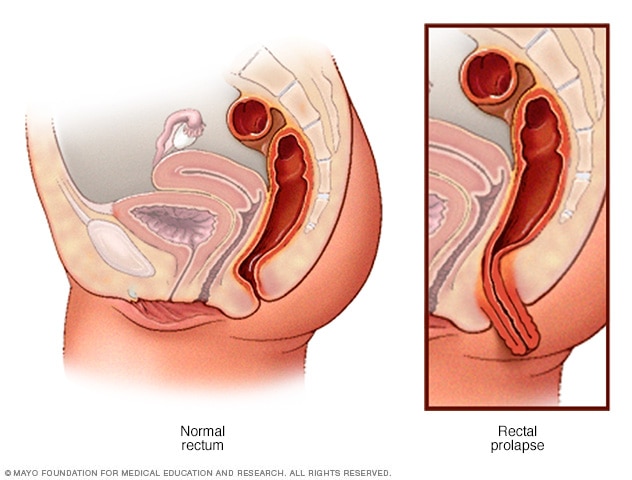Rectal prolapse
Updated: 2023-05-27
Overview

Rectal prolapse
Rectal prolapse occurs when the rectum becomes stretched out and slips out of the anus.
Rectal prolapse happens when part of the large intestine's lowest section, the rectum, slips outside the muscular opening at the end of the digestive tract known as the anus. While rectal prolapse may cause pain, it's rarely a medical emergency.
Rectal prolapse is sometimes treated with stool softeners, suppositories and other medicines. But surgery is usually needed to treat rectal prolapse.
Symptoms
If you have rectal prolapse, you may notice a reddish lump that comes out of the anus, often while straining during a bowel movement. The lump may slip back inside the anus, or it may continue to be seen.
Other symptoms may include:
- You cannot control your bowel movements, known as fecal incontinence.
- Constipation or loose stools.
- Leaking blood or mucus from the rectum.
- Feeling that your rectum isn't empty after a bowel movement.
Causes
The cause of rectal prolapse is unclear. Though it's a common belief that rectal prolapse is related to childbirth, about one-third of women with this health problem never had children.
Risk factors
Some things may increase your risk of getting rectal prolapse, including:
- Sex. Most people with rectal prolapse are women.
- Age. Rectal prolapse most often happens in people over age 50.
- Constipation. Straining may increase the risk of rectal prolapse.
Diagnosis
Sometimes it can be hard to tell the difference between rectal prolapse and hemorrhoids. To find rectal prolapse and rule out other related health problems, your health care provider may suggest:
- Digital rectal exam. Your health care provider places a gloved and lubricated finger into your rectum to check the strength of your sphincter muscles and to check for any problems in the rectal area. During the exam, your health care provider may ask you to bear down, to check for rectal prolapse.
- Anal manometry. A narrow, flexible tube is inserted into the anus and rectum. A small balloon at the tip of the tube may be blown up. This test helps measure the tightness of your anal sphincter and how your rectum is working.
- Colonoscopy. To rule out other conditions, such as hemorrhoids, polyps or colon cancer, you may have a colonoscopy, in which a flexible tube is placed in your rectum to look at all of the colon.
- Defecography. This test adds the use of a dye to an imaging study, such as X-ray or magnetic resonance imaging (MRI). Defecography can help show structural changes in and around your lower digestive tract and find out how your rectal muscles are working.
Treatment
Treatment for rectal prolapse often involves surgery. Treatment for constipation with stool softeners, suppositories and other medicines are often needed. There are different surgical methods for treating rectal prolapse. Your health care provider will pick the best treatment for you after going over your age, health problems and how your bowels work.